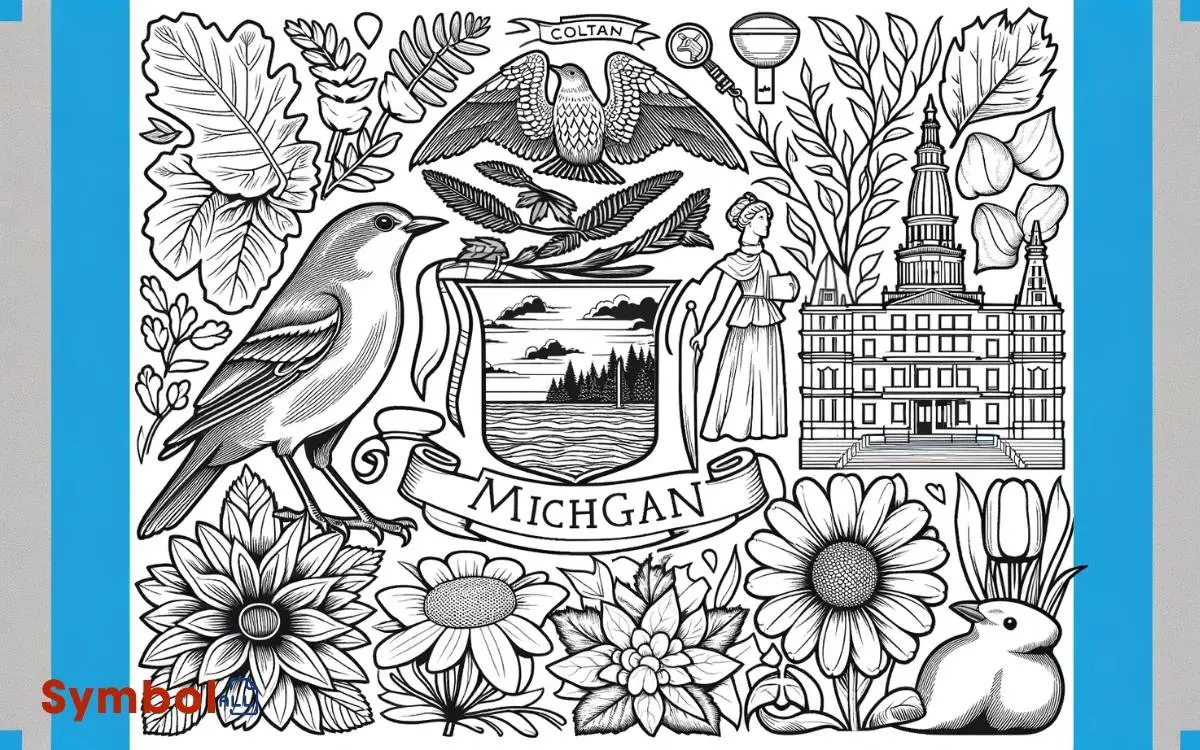Michigan State Symbols Coloring Pages: Explains!
You’re in for a treat with Michigan’s state symbols coloring pages. Picture the Robin, your canvas awaits its bright red breast, a herald of spring. Imagine shading the towering White Pine, Michigan’s stately tree, symbolizing strength.
Don’t forget the Apple Blossom‘s pink and white hues, an ode to agricultural heritage. Your palette will light up with the Brook Trout’s vibrant patterns and the Painted Turtle‘s colorful markings.
Each color you lay down brings you closer to Michigan’s heart, from its rich ecosystems to its architectural marvels like the Mackinac Bridge. As you color, you’ll uncover more about what makes Michigan unique.

Key Takeaways
10 Michigan State Symbols Coloring Pages
| Symbol Name | Description |
|---|---|
| State Bird: Robin | The American Robin, characterized by its red breast |
| State Flower: Apple Blossom | Known for its fragrant pink and white flowers |
| State Tree: Eastern White Pine | The largest pine species in the U.S. |
| State Fish: Brook Trout | A freshwater fish native to Michigan’s streams |
| State Stone: Petoskey Stone | A rock that is composed of a fossilized coral |
| State Gem: Chlorastrolite | Also known as the “green star stone” or “Isle Royale greenstone” |
| State Game Mammal: White-tailed Deer | A key species in Michigan’s ecosystem and popular in recreational hunting |
| State Fossil: Mastodon | An extinct mammal that roamed North America |
| State Reptile: Painted Turtle | Known for its colorful markings on its shell |
| State Wildflower: Dwarf Lake Iris | A rare wildflower found in Michigan’s shores |
Robin: State Bird
Adorning Michigan skies, the Robin proudly stands as the state’s official bird, symbolizing the arrival of spring with its cheerful song.
You’ve likely seen this friendly bird hopping across your lawn, searching for worms after a rain. With its bright red breast and melodious calls, the Robin isn’t just a sign of warmer days ahead but also an integral part of Michigan’s natural heritage.
Since its designation in 1931, the Robin has captured the hearts of Michiganders, embodying resilience and renewal.
As you color in its image, remember the joy this bird brings at winter’s end. Its presence uplifts spirits, making it a beloved symbol throughout the state.
Let your colors reflect the Robin’s vibrant energy and its special place in Michigan’s ecosystem.
White Pine: State Tree
Towering above the Michigan landscape, the White Pine, designated as the state tree, stands as a majestic symbol of strength and beauty.
This evergreen conifer, known scientifically as Pinus strobus, plays a pivotal role in Michigan’s natural and cultural heritage.
With its long, soft needles grouped in bundles of five and its large, slender cones, the White Pine isn’t only a sight to behold but also a crucial part of the ecosystem.
It provides habitat for wildlife, contributes to the state’s lumber industry, and offers shade and beauty to Michigan’s parks and forests.
As you color in your Michigan State Symbols Coloring Pages, remember the White Pine’s enduring presence, a demonstration of nature’s resilience and the state’s rich history.
Apple Blossom: State Flower
You’ll find the apple blossom holds a special place in Michigan’s heart, symbolizing renewal and growth. Its vibrant hues span across a spectrum, making each blossom variety a sight to behold during their peak blooming season in spring.
Understanding its significance and the colorful varieties brings a deeper appreciation for why it’s Michigan’s cherished state flower.
Apple Blossom Significance
The apple blossom, Michigan’s state flower, symbolizes the state’s rich agricultural heritage and its role in the fruit industry.
When you see the delicate pink and white flowers dotting the landscape, you’re witnessing a confirmation to the enduring spirit of Michigan’s farmers and the state’s pivotal place in apple production.
Adopted in 1897, this choice wasn’t just about beauty; it was a nod to the apple orchards that contribute greatly to the local economy and the state’s identity.
The apple blossom represents renewal and growth, mirroring Michigan’s seasons and the cycle of life in agriculture.
Embracing this symbol, you’re not just acknowledging a flower but celebrating the resilience and hard work that define Michigan’s communities and their contributions to the nation’s fruit basket.
Colorful Blossom Varieties
Diving into the world of apple blossoms, you’ll discover a spectrum of colors that not only captivate the eye but also tell a story of diversity and beauty within Michigan’s orchards.
Each variety of apple tree presents its own unique hue of blossoms, ranging from the purest whites to the deepest pinks. These blossoms are more than just a feast for the eyes; they’re an essential part of the ecosystem, attracting pollinators necessary for the fruit’s growth.
The delicate shades of the blossoms reflect the tree’s variety, with some displaying a soft blush pink, while others boast vibrant, almost cerise tones.
This colorful display isn’t just aesthetic; it’s a critical stage in the lifecycle of Michigan’s apple trees, contributing significantly to the state’s agricultural richness.
Seasonal Blooming Period
Upon discovering the vibrant hues of apple blossoms, it is important to recognize when these stunning flowers make their appearance, signaling a significant period in Michigan’s agricultural calendar.
In April, you’ll start to see the first hints of color as the apple blossoms begin to unfurl. By May, they’re in full spectacle, coating orchards in a blanket of pink and white.
It’s a fleeting but magical time that heralds the start of warmer days and fruitful harvests ahead. Don’t miss it!
Brook Trout: State Fish
Swimming through Michigan’s freshwater streams, the Brook Trout holds the prestigious title of the state fish. This vibrant creature isn’t just a sight to behold; it’s a symbol of Michigan’s rich aquatic ecosystems.
The Brook Trout, with its distinctive marbled pattern and shades of green and red, thrives in the cold, clear waters that define Michigan’s natural beauty.
You’ll find that the Brook Trout is more than just a fish; it’s a demonstration of the state’s commitment to environmental preservation and wildlife management.
Its designation as the state fish in 1988 underscores Michigan’s dedication to protecting its natural habitats.
Painted Turtle: State Reptile
Basking in the sun on logs and rocks across Michigan, the Painted Turtle proudly serves as the state’s official reptile.
You’ll recognize it by its distinctive, colorful markings: a dark shell beautifully bordered with red and yellow stripes, and similarly striking lines adorning its neck and legs.
This charming creature isn’t just a delight to spot during your outdoor adventures; it plays a key role in Michigan’s aquatic ecosystems by helping control insect populations.
The Painted Turtle’s preference for calm waters, like ponds and marshes, makes it accessible for viewing and an endearing subject for your coloring pages.
Embrace the opportunity to color this beloved Michigan symbol, bringing its vivid patterns to life with your creativity.
White-tailed Deer: State Game Mammal
After exploring the vibrant world of the Painted Turtle, let’s turn our attention to another cherished Michigan symbol, the White-tailed Deer, known as the state’s official game mammal.
Graceful and widely recognized by its namesake tail, the White-tailed Deer plays a significant role in Michigan’s natural heritage and ecosystem.
You’ll find these majestic animals throughout the state, from dense forests to open fields. They’re not just a sight to behold but also vital for hunting traditions that contribute to wildlife management and conservation efforts.
Coloring their image, you’ll capture the essence of Michigan’s wilderness and the importance of this species in maintaining ecological balance. It’s a perfect way to appreciate the state’s diverse fauna and the role each plays in the environment.
Dwarf Lake Iris: State Wildflower
Why not explore the enchanting world of the Dwarf Lake Iris, Michigan’s treasured state wildflower, and discover its unique charm and significance?
This rare beauty thrives in the Great Lakes region, especially favoring Michigan’s northern shores. With its vibrant blue and purple petals, the Dwarf Lake Iris isn’t just a delight for the eyes. It’s an essential part of the local ecosystem, supporting various pollinators.
Designated as the state wildflower in 1998, it symbolizes Michigan’s commitment to preserving its natural heritage. However, it’s also a reminder of the fragility of our environment, being federally listed as a threatened species.
Kalkaska Sand: State Soil
Did you know Kalkaska sand is Michigan’s state soil and plays an essential role in the environment?
This unique soil formation supports various agricultural practices and is crucial for certain ecosystems. Let’s explore how Kalkaska sand came to be and why it’s so important.
Kalkaska Sand Formation
Kalkaska Sand, recognized as Michigan’s state soil, plays an important role in the state’s agricultural and natural landscapes. This unique soil wasn’t created overnight; it’s the result of thousands of years of geological processes.
You’ll find it fascinating that during the last Ice Age, glaciers sculpted the land and left behind a mix of materials that, over millennia, developed into the Kalkaska Sand we recognize today.
As these glaciers retreated, they also ground down rock into fine particles, which mixed with organic matter to form this well-drained, sandy soil.
It’s spread across a significant portion of northern Michigan, covering nearly one million acres. This extensive coverage makes Kalkaska Sand a fundamental part of Michigan’s natural heritage, shaping both the environment and the state’s identity.
Soil Uses & Importance
Understanding the significance of Kalkaska Sand, Michigan’s state soil, reveals its pivotal role in supporting diverse agricultural practices and preserving natural ecosystems throughout the region.
You’ll find that Kalkaska Sand isn’t just any soil; it’s the backbone of Michigan’s lush landscapes and bountiful harvests. Its well-drained nature makes it perfect for growing cherries, apples, and grapes, which are key to the state’s agricultural economy.
Beyond farming, this soil supports forests that are home to a wide array of wildlife, playing an essential role in biodiversity.
Kalkaska Sand’s unique properties also aid in water filtration and conservation, highlighting its importance not just for agriculture but for maintaining the health of Michigan’s natural water systems.
Petoskey Stone: State Stone
The Petoskey Stone, Michigan’s state stone, holds a unique charm and geological history that you’ll find fascinating.
It’s not just any stone; it’s a fossil of coral that lived in warm shallow seas during the Devonian era, about 350 million years ago. When you hold a Petoskey Stone, you’re literally holding a piece of ancient history.
Here are three quick facts to enhance your appreciation:
- Distinct Pattern: The stone is easily recognized by its unique hexagonal pattern, resembling a honeycomb.
- Location: You can find them along the shores of Lake Michigan, particularly around the city of Petoskey.
- Polishing: When polished, these stones reveal a stunning range of grey and white colors, making them popular for jewelry and decorative items.
Isn’t nature’s artistry just amazing?
Isle Royale Greenstone: State Gem
Just as the Petoskey Stone captures a piece of Michigan’s ancient past, Isle Royale Greenstone, the state’s designated gem, holds its own unique and mesmerizing story.
Found primarily in the Upper Peninsula, particularly on Isle Royale, this rare gem is a true treasure of the state.
Characterized by its striking green color with intricate patterns, Isle Royale Greenstone, or chlorastrolite, is highly sought after by collectors and jewelers alike. It’s not just its beauty that makes it special; its rarity and location-specific occurrence add to its allure.
When polished, its turtleback pattern becomes even more pronounced, making it a compelling choice for jewelry. Embracing this gem is embracing a piece of Michigan’s natural history, a symbol of the state’s geological diversity and beauty.
American Elm: State Urban Tree
You’re about to learn why the American Elm holds the title of Michigan’s State Urban Tree.
Its unique characteristics and significant role in urban environments highlight its importance, while ongoing conservation efforts aim to protect this majestic species for future generations.
Let’s explore what makes the American Elm stand out and why it’s worth preserving.
American Elm Characteristics
Renowned for its majestic stature and vibrant green foliage, the American Elm serves as a distinguished urban tree across Michigan’s landscapes.
Here’s what you need to know about this iconic tree:
- Height and Form: The American Elm can soar up to 100 feet tall. Its unique vase-shaped growth pattern, featuring a broad, spreading canopy, makes it a standout feature in any setting.
- Leaves and Bark: You’ll recognize its leaves by their asymmetrical base and serrated edges, turning a brilliant yellow in the fall. The bark is deeply furrowed, adding texture and interest.
- Resilience: Despite its susceptibility to Dutch elm disease, the American Elm has shown remarkable resilience, with disease-resistant varieties ensuring its continued presence in urban and rural landscapes alike.
These characteristics make the American Elm a treasured component of Michigan’s natural heritage.
Elms Urban Significance
Throughout Michigan’s urban landscapes, the American Elm stands tall as the state’s celebrated urban tree, embodying both beauty and resilience in city settings.
Its grand stature and lush canopy provide not just shade but also a scenic backdrop that enhances urban aesthetics.
You’ll find these magnificent trees lining the streets, in parks, and throughout public spaces, contributing greatly to the urban ecosystem.
| Feature | Benefit |
|---|---|
| Large Canopy | Provides ample shade |
| Aesthetic Appeal | Enhances urban landscapes |
| Environmental Impact | Improves air quality, supports wildlife |
Their presence in cities isn’t just about looks; they play an important role in improving air quality and offering habitat for urban wildlife.
The American Elm’s ability to thrive in urban environments makes it a symbol of strength and adaptability, reflecting the enduring spirit of Michigan’s communities.
Conservation Efforts Today
To safeguard the American Elm, Michigan’s cherished urban tree, ongoing conservation efforts are essential in combating diseases and environmental threats.
Here’s how you can contribute:
- Support Local Arborist Initiatives: Participate in community tree planting events or donate to organizations focused on treating and preventing diseases like Dutch elm disease.
- Educate Yourself and Others: Learn about the American Elm’s significance and share knowledge on how to care for these trees, ensuring they thrive in urban settings.
- Advocate for Green Spaces: Encourage your local government to invest in green spaces that include the American Elm, highlighting its importance as a state symbol and its role in enhancing urban biodiversity.
Eastern White Pine: State Historical Tree
Standing tall as Michigan’s State Historical Tree, the Eastern White Pine has a rich history intertwined with the state’s development.
This majestic tree once covered much of Michigan, serving as an essential resource for Native Americans and early settlers. Its strong, straight timber was perfect for building homes, ships, and even the bustling cities of the burgeoning United States.
Beyond its practical uses, the Eastern White Pine symbolizes the natural beauty and resilience of Michigan. Its designation as the State Historical Tree in 1955 acknowledges its significant contribution to the state’s economy and culture throughout history.
When you color the Eastern White Pine, you’re not just filling in a tree; you’re connecting with a piece of Michigan’s storied past.
Mackinac Bridge: State Engineering Marvel
Spanning the Straits of Mackinac, the Mackinac Bridge connects Michigan’s upper and lower peninsulas, showcasing an engineering feat that’s not only functional but breathtakingly beautiful.
As you consider adding your colors to this marvel, here are three fascinating aspects to inspire your palette:
- Length and Grace: Stretching about 5 miles, it’s among the world’s longest suspension bridges, a proof of human ingenuity.
- Historical Significance: Completed in 1957, it symbolized a new era in transportation, uniting communities and economies.
- Natural Beauty: Set against the backdrop of vast waters and skies, it offers a mesmerizing view that changes with the seasons.
As you color the Mackinac Bridge, imagine the blend of strength and elegance it represents, a true engineering marvel that’s as much a part of Michigan’s identity as its natural landscapes.
Conclusion
Imagine Michigan as a vast, colorful tapestry, with each thread representing one of its cherished state symbols.
From the robin’s cheerful melody at dawn to the stoic Mackinac Bridge standing guard over the Great Lakes, these icons weave together the state’s rich heritage and natural beauty.
Like the intricate patterns of the Isle Royale Greenstone, they tell a story of resilience and diversity. So grab your crayons, and let’s bring this vibrant mosaic to life on your coloring pages.






